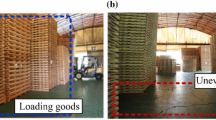Abstract
This paper presents a new sonar based landmark to represent significant places in an environment for localization purposes. This landmark is based on extracting the contour free of obstacles around the robot from a local evidence grid. This contour is represented by its curvature, calculated by a noise-resistant function which adapts to the natural scale of the contour at each point. Then, curvature is reduced to a short feature vector by using Principal Component Analysis. The landmark calculation method has been successfully tested in a medium scale real environment using a Pioneer robot with Polaroid sonar sensors.
Similar content being viewed by others
Explore related subjects
Discover the latest articles, news and stories from top researchers in related subjects.References
Anousaki GC, Kyriakopoulos KJ (1999) Simultaneous localization and map building for mobile robot navigation. IEEE Rob Autom Mag 6(3):42–53
Brown RG, Donald BR (2000) Mobile robot self-localization without explicit landmarks. Algorithmica 26:515–559
Crowley JL, Pourraz F (2001) Continuity properties of the appearance manifold for mobile robot position estimation. Image Vis Comput 19:741–752
Elfes A (1987) Sonar-based real-world mapping and navigation. IEEE J Rob Autom 3:249–265
Holliday JD, Hu CY, Willet P (2002) Grouping of coefficients for the calculation of inter-molecular similarity and dissimilarity using 2d fragment bit-strings. Comb Chem High Throughput Screen 5(2):155–166
Holliday JD, Salim N, Whittle M, Willet P (2003) Analysis and display of the size dependence of chemical similarity coefficients. J Chem Inf Comput Sci 43:819–828
Levitt TS, Lawton DT (1990) Qualitative navigation for mobile robots. Artif Intell 44(3):305–360
McGillen CD, Rappaport TS (1989) Beacon navigation method for autonomous vehicle. IEEE Trans Vehicular Technol 9(3):132–139
Moravec HP (1988) Sensor fusion in certainty grids for mobile robots. AI Mag 9:61–74
Srivastava A, Mio W, Klassen E, Liu X (2003) Geometric analysis of constrained curves for image understanding. In: Proceedings of the 2nd IEEE workshop on variational, geometric and level set methods in computer vision 2003, Nice, France
Tamimi H, Zell A (2004) Vision based localization of mobile robots using kernel approaches. In: Proceedings of the 2004 IEEE/RSJ international conference on intelligent robots and systems (IROS 2004), Sendai, Japan, September–October, pp 1896–1901
Urdiales C, Bandera A, Ron R, Sandoval F (1999) Real time position estimation for mobile robots by means of sonar sensors. In: Proceedings of the 1999 IEEE international conference on robotics and automation (ICRA 1999), USA, pp 1650–1655
Urdiales C, Trazegnies C, Bandera A, Sandoval F (2003) Corner detection based on adpatively filtered curvature funcion. Electronics lett 39(5):426–428
Vlassis N, Motomura Y, Krose B (2002) Supervised dimension reduction of intrinsically low-dimensional data. Neural Comput 14(1):191–215
Yamauchi B, Beer R (1996) Spatial learning for navigation in dynamic environments. IEEE Trans Syst Man Cybern 6(26):496–505
Author information
Authors and Affiliations
Corresponding author
Rights and permissions
About this article
Cite this article
Poncela, A., Urdiales, C., Trazegnies, C.d. et al. A New Sonar-based Landmark for Localization in Indoor Environments. Soft Comput 11, 281–285 (2007). https://doi.org/10.1007/s00500-006-0069-3
Published:
Issue Date:
DOI: https://doi.org/10.1007/s00500-006-0069-3




